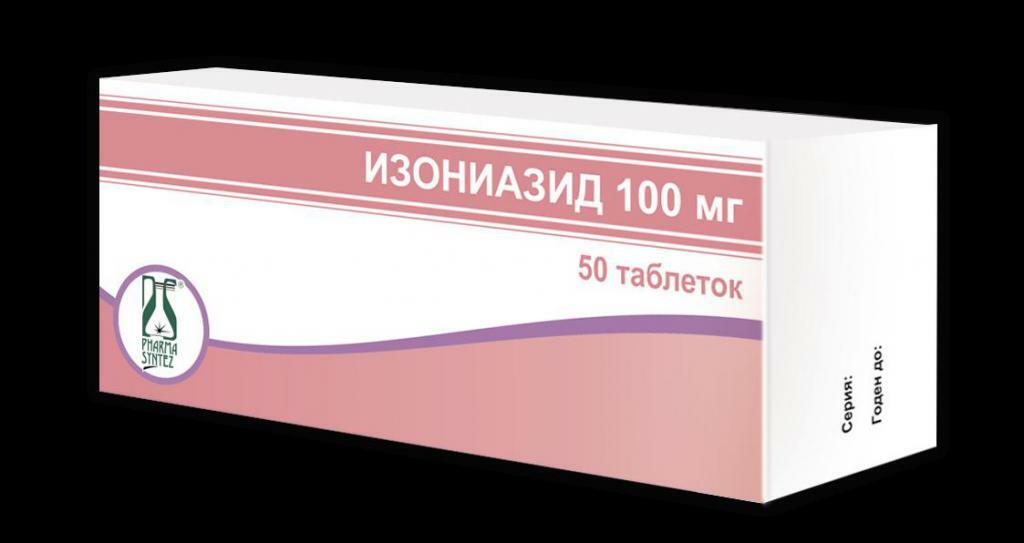Tablets "Izoniazid": side effect, instruction, reviews
Despite the fact that such a disease as tuberculosis has long been successfully treated, it is still considered one of the most dangerous among the townsfolk. There are a lot of rumors about him. The same goes for medicines that are being produced for the treatment of the disease. Tablets "Izoniazid" are very effective at certain stages of the disease. However, their patients for some reason are afraid of their destination. Today we will consider the side effect of "Isoniazid", and also tell about its forms of release and dosage. Perhaps the information below will be useful to some categories of readers.

Brief description of the preparation
Immediately specify that "Izoniazid" from tuberculosis is not appointed in all cases. It is most effective at the initial stage of the disease, when the body has not yet had much to suffer from the sticks of Koch. As you know, it is she who causes the disease. If you start treatment on time, then the drug can destroy actively developing sticks, as well as mycobacteria, located inside the cells and outside them.
It is noteworthy that until now pharmacists who manufacture such a remedy can not exactly describe the mechanism of its effect on Koch's wand. It is assumed that the drug suppresses the intracellular synthesis of bacteria. This is what stops their reproduction and the course of the disease.
It should be noted that "Izoniazid" doctors are often prescribed for preventive purposes. Sometimes it is prescribed for persons who have successfully undergone treatment for tuberculosis. Also, the drug is taken and patients with a positive Mantoux reaction. This number includes children and adolescents.
Forms of release
When treating Isoniazid, specialists use different forms of its release. Defines the necessary doctor depending on the age of the patient and the course of the disease. We briefly enumerate all known forms of this popular and effective drug:
- Tablets "Isoniazid."One capsule usually contains 100, 200 or 300 milligrams of the active substance. Placed tablets are mostly 10 pieces in one blister. The package can contain 2, 5 and 10 blisters. Since the drug treatment stretches for a fairly long time, the manufacturers are provided and more capacious packaging. For example, in banks, 100, 500 and 1000 tablets are packed. Capsules in a dosage of 300 milligrams are packaged in 100 pieces in cans. Packs the medicine manufacturer and packages. Their maximum number in this case reaches 1000 tablets in a container.
- Solution for injection. It is ten percent, in one ampoule contains 5 milligrams of active substance. Usually in one package there are from 5 to 10 bubbles.
- Syrup. This form implies packing in vials of dark glass. In each, there are 200 milliliters of the drug. In five milliliters of syrup, the concentration of the active substance does not exceed 100 milligrams.
- Powder. Its concentration is usually identical to the tablet form, in this form the drug is administered, mainly to children. But even in this case it is used extremely rarely.
If to speak about the side effect of "Isoniazid", then it does not change depending on the form in which the drug is used by the patient. Therefore, it is worthwhile to listen to the opinion of the attending physician and focus on it.
Composition of the drug
Depending on the dosage, one tablet of the preparation contains from 100 to 300 mg of isoniazid. It is he who is the active substance of the drug. The following components are used as auxiliary components:
- potato starch;
- stearic acid.
Tablets are flat and white in color. On the surface there are risks for the convenience of division.
One milliliter of solution for injection contains 100 mg of isoniazid. It is worth considering that the injections can be done both intravenously and intramuscularly. It depends on the doctor's prescription.

Indications for use
We have already mentioned that the drug is prescribed in different cases. We list the most common indications for the use of isoniazid:
- Active forms of tuberculosis, regardless of its location in the body. Judging by the opinions of specialists, the drug proved to be very effective at the initial stages of the disease. If you start taking it immediately after infection, the chances of a quick healing increase several times.
- Tuberculous meningitis. Usually in such a case doctors prescribe not only "Izoniazid", but also other drugs. As part of complex therapy, he is very effective and helps to cope with the disease.
- Persons who are in close contact with tuberculosis patients. If your close relative suffers from this disease, then most likely you will be prescribed this drug as a prophylaxis.
- For children, adolescents and adults, who have a positive reaction to the Mantoux test. For kids under the age of four, a spot 10 millimeters in size is considered dangerous, for adults it is more than five millimeters.
- For children and adolescents who were infected with Koch's wand for the first time, as well as suffering severe infectious diseases in parallel. These include pneumonia or measles, for example.
- Patients diagnosed with HIV.
- Persons engaged in livestock farming and in the nature of their activities are forced to contact a sick tuberculosis animal.
- With residual forms of tuberculosis.
It is worth considering that before the appointment of the drug the patient undergoes a thorough examination. It includes radiology and phthisiatric consultation. Only after this the doctor decides whether it is worth writing out Isoniazid. By the way, he always describes side effects of the drug to his patients.

Pharmacokinetics
Many patients are primarily concerned about the side effects of Isoniazid indicated in the instructions in adults and children. However, it is equally important to understand how it works in the human body.
Pharmacists claim that the drug is absorbed very quickly in the digestive tract. Usually it is prescribed after a meal, as its digestion significantly slows down the effect of the drug. In the interval from one to four hours, the maximum concentration of the substance in the body is reached. It is noteworthy that, after a single dose, isoniazid is active in the blood of a person up to a day. All this time he fights with a stick of Koch, and therefore is very effective after the first pill.
It should be noted that the drug perfectly penetrates all tissues of the body. It is also able to overcome the placental barrier and enter the breast milk. Many patients attribute this to the side effects of Isoniazid tablets.

Contraindications to the preparation
Before taking the tablets, it is worth considering not only the possible side effects of isoniazid, but also its contraindications. Unfortunately, such a list is quite wide, so the medicine is not in the pharmacy freely available. You can buy it only by prescription of the attending physician, and therefore after his consultation.
So, first of all, tablets should not be taken to people with the following problems:
- intolerance to the components of the drug;
- diseases of the nervous system, including epilepsy;
- with various mental illnesses;
- with kidney and liver diseases;
- poliomyelitis, transferred in childhood;
- exacerbation of eczema;
- with thyroid problems;
- with hypertension;
- heart disease;
- asthma and other problems with the lungs.
In especially severe cases, individuals with listed diseases still get Isoniazid. However, the dosage is minimal. If you have a diagnosis in the medical record such as phlebitis, then the drug is used only intravenously.
A few words about the course of treatment
Judging by the reviews, the instructions to "Isoniazid" indicate that it can be used in many ways. The attending physician, assessing the course of the illness, determines which treatment course to appoint to the patient. Most often, the drug is taken orally. You can also put it intravenously and intramuscularly in the form of injections. In addition, there is a way to be treated by inhalation. In particularly severe cases, when the disease develops rapidly, specialists introduce Isoniazid into the cavity. This cavity is formed in the lungs as a result of the action of the Koch's rod in the patient's body.
If, after the first days of taking Isoniazid, side effects in adults( we'll mention more about them later in the article) did not come to light, then during the course of treatment he will take pills. Otherwise, the doctor may change them for injections. After a shot, it is recommended not to get up for an hour and a half, this reduces the risk of unpleasant side effects.
It is necessary to adhere to a special diet, which is prescribed for patients with Isoniazid. Usually it consists in excluding certain foods from the diet. Such a list includes cheeses and certain types of fish.

Dosage for adults
When you prescribe a prescription, the doctor always starts from a dosage of not more than fifteen milligrams per kilogram of body weight. With this approach, the daily dose is 600 to 900 mg of the active substance. This amount is distributed 3 times. In a single dose, you can not exceed a dose of 600 milligrams.
All the time the doctor carefully watches the patient's condition. Depending on its metabolism, the presence of chronic diseases and its state of health, the dose may vary.
If you are prescribed injections, then the expert starts from a dosage of 15 mg per kilogram of weight. In some cases this concentration may be reduced to 5 mg. The course of treatment with "Isoniazid" injections lasts from two to five months. And it is worth considering that after each injection you need to take vitamin B6 and glutamic acid.
If the doctor has prescribed prophylaxis with the drug, the course of treatment lasts no more than three months. In this case, side effects of "Isoniazid" in adults are practically not observed. After all, the dosage of the active substance does not exceed 10 mg per one kilogram of body weight.
Purpose of the drug for children
Because of the side effects of "Isoniazid" in children, parents quite often refuse to take it. However, this is fundamentally the wrong decision. After the first months, the disease can be asymptomatic, and later it will manifest itself in full. Therefore, it is better to stop it at an initial stage than in the future to take more serious medicines in higher dosage.
"Isoniazid" is prescribed for children, starting from 15 mg per one kilogram of the child's weight. The maximum concentration of the drug per day should not exceed five hundred milligrams. Since the dose is always determined individually, one-time administration can be reduced to five milligrams per kilogram.
If the baby is prescribed injections, then after them it is also accepted to take vitamins, as well as to adult patients. In the case of injections, the dose is calculated at a rate of ten to fifteen milligrams per kilogram of the child's weight.
"Isoniazid": side effects in children
The instructions for use indicate quite a few negative consequences of taking the drug. However, children react to this drug in their own way. They have pain in the right upper quadrant, convulsions, sleep disorders, nausea and allergic reactions.
If your child has a similar symptomatology for more than two days, then it is worthwhile to see a doctor. He examines a small patient and, if necessary, reduces the dosage. If the situation does not change, then the drug can be replaced with a similar drug.

General list of adverse reactions
It is not always the doctors who manage to choose the right dosage of the medicine from the first time, so the patient may face a number of unpleasant consequences. How are they manifested?
Most often, patients are allergic to the active substance. It manifests itself in the form of strong skin itching, rashes of different nature and increased body temperature. Sometimes an allergic reaction is accompanied by pain in joints that do not go away for several days.
The nervous system also reacts quite sensitively to Isoniazid. On her part, the reactions can be extremely diverse. Many face depression and insomnia, which lead to increased irritability and headaches. In some cases, weakness, convulsions and even epileptic seizures may occur.
Some patients note that when taking tablets, they constantly experienced nausea, vomiting, diarrhea and pain in the gastrointestinal tract.
Patients who had previously observed high blood pressure, during the course of treatment, noticed angina, attacks of hypertension and cardiac arrhythmias.
Taking the drug during pregnancy
We already wrote about the fact that the active substance easily overcomes the placental barrier and penetrates into breast milk. Therefore, the baby in the womb will also experience the effect of the drug. However, for certain indications, doctors can prescribe "Isoniazid" during pregnancy and during lactation.
Typically, a specialist calculates the dosage based on ten milligrams per kilogram of a woman's weight. Increase the concentration of the drug in any case impossible. In some cases, the doctor even reduces it, focusing on the well-being of her patient.

Isoniazid: reviews of side effects and use of
Many of the patients who left reviews on the Internet noted that in the early days they suffered greatly from side effects of the drug. Most of them experienced nausea, vomiting and abdominal pain. However, after a few days the body adapted to taking the tablets and all the negative reactions disappeared. Some have been helped by vitamins, which were prescribed by the attending physician to reduce the side effects.
If we talk about the effectiveness of the drug, then its patients are estimated quite high. Many managed to cope with the disease in a few months, and later they took the medicine once a year as a preventive measure. Therefore, we can say that in cases of tuberculosis, Isoniazid should be taken immediately after the first order of the doctor. This will avoid more serious complications, as well as reduce the risk of chronic disease.
